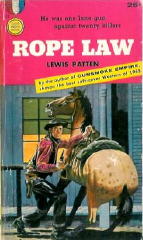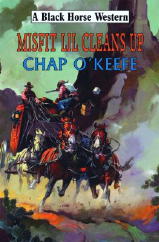Fri 5 Sep 2008
The latest issue of the online magazine Black Horse Extra is out, devoted primarily as always the western fiction recently put out by UK publisher Robert Hale, but again, as always, branching out in many different ways.

For example, in this, the September-November 2008 issue, the main topic is an attempt to answer the question, Can western fiction also be noir?
If I’d been asked before reading this issue, except for a tendency for traditional westerns most often to have happy endings, my answer would have been yes, of course. Happily I’m reinforced in that opinion by James Reasoner’s comments about one of his current favorite western authors, Lewis Patten (1915-1981) in a review of Rope Law (Gold Medal, 1956), about which he says in part:
“… as the posse waits for nightfall so they can close in, Patten backtracks to fill in the story of what brought the characters to this point, and it’s a years-long saga of drunkenness, prostitution, robbery, and murder worthy of any of the more contemporary Gold Medal’s. Sex serves as the motivation for most of this, and while the scenes aren’t graphic, there are quite a few of them for a traditional western published in 1956.”
Chap O’Keefe (aka Keith Chapman, who leaves comments here under one or the other of each of the two names every once in a while) follows with story descriptions of several of Patten’s other books, one or two of which I’ve read myself, reviews of which I really ought to post here sometime soon. Chap points out in each of them what in his opinion makes them noir, including the imagery of the writing.
From Giant on Horseback (Ace,1964) for example; “Rain fell, gently drizzling, shining on the slicker worn by the stationmaster, dripping softly from the eaves of the weather-beaten, yellow-frame station. The train hissed patiently as it waited for the passenger to alight. . . .”

Concerning “happy endings,” James suggests that authors were constrained into doing so by editors, and Chap follows up by pointing out that editors still have great influence in that direction today.
In that regard, he goes into specific detail with a behind-the-scenes look at what his editors wanted (and didn’t want) in two of his own most recent books, A Gunfight Too Many and Misfit Lil Cleans Up, both published by Hale under their Black Horse imprint, which makes for very interesting reading.
If you’re a fan if either western or noir fiction, you’ll want to read the whole issue yourself. And I haven’t even begun to mention any of the other interviews and news items it contains. (How old is Ernest Borgnine? And what western movie is he going to be in next??)
September 6th, 2008 at 12:14 pm
I’ve been watching some western movies lately that have some noirish themes: Pursued, The Furies, Man of the West. Naturally I also want to read any western noir novel. I dug up my copy of Patten’s Gold Medal paperback, ROPE LAW and just started reading it. Great beginning as the aging lawman thinks back over the past. I find that I’m interested more and more in aging, elderly characters. I wonder why that is?
September 6th, 2008 at 12:35 pm
The subject of western noir could fill an entire book, though as far as I know, there hasn’t been one written. (If I’m wrong, I’d be delighted to be corrected.)
The movies you mention, Walker, came out in 1947, 1950 and 1958, respectively, back in the era of “true” noir films.
You’d have to tell me if any of these three have “happy endings,” but once we get into the 1960s and “adult westerns” came along, the list of “western noir” films has to have grown tenfold, if not more.
If only we had a good definition of “noir.”
But the same is true in western fiction, not just books. A history of the western novel will show more and more crossover with noir as the years go on.
A terrific current example — not to slight other contemporary writers — was pointed out a while ago by Bruce Grossman in a review of Ed Gorman’s Ghost Town, at bookgasm, and I know he’s written many others that would qualify.
But as for your final question, Walker, I simply have no idea.
September 6th, 2008 at 3:41 pm
Whatever the answer, there is a perception — held rightly or wrongly — that westerns are now a genre that appeals only to an older, male age group. In a way, I catered to it recently with A Gunfight Too Many. But I don’t believe the readership is that narrow.
A few years back, another Black Horse Western writer said in a writers’ magazine that central characters for the line had to be male. About the same time, I was beginning a series of books about scallywag young western heroine Miss Lilian Goodnight.
The “Misfit Lil” saga is now up to book #6.
Keith
September 6th, 2008 at 4:44 pm
Chap
Maybe us older males are attracted to characters like Misfit Lil. From an review on Amazon.uk:
“… independent-minded tough cowgirl Lilian Goodnight. Lil is a fine horsewoman, expert at roping calves and driving cows and is an excellent shot with a pistol too. Apparently, she can also out-cuss her father’s ranch-hands.”
— Steve
September 6th, 2008 at 10:59 pm
Steve
That is a thought!
Then again, I’m told by one of the other BHW writers who belongs to an online discussion group that “a young lady on there was quite impressed with Misfit Lil”, and later “the young lady concerned stated that she liked feisty women.”
For some reason, I felt ridiculously pleased that a reader who wasn’t male and was young had taken the time not only to read but to express her enthusiasm for a western series. The marketing people would have us believe that this never, absolutely cannot happen!
When I began the Lil books, I introduced the character in an article that can be found in the Extra’s Backtrails (archives). It’s at http://www.blackhorsewesterns.com/bhe3
Keith